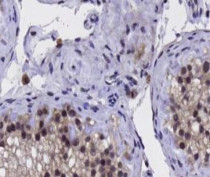ARG44926
anti-SAP18 antibody
anti-SAP18 antibody for IHC-Formalin-fixed paraffin-embedded sections and Human
Overview
| Product Description | Mouse Monoclonal antibody recognizes SAP18 |
|---|---|
| Tested Reactivity | Hu |
| Tested Application | IHC-P |
| Host | Mouse |
| Clonality | Monoclonal |
| Isotype | IgG2a |
| Target Name | SAP18 |
| Antigen Species | Human |
| Epitope | EIKKEPEKPI DREKTCPLLL RVFTTNNGRH HRMDEFSRGN VPSSELQIYT WMDATLKELT SLVKEVYPEA RKKGTHFNFA IVFTDVKRPG YRVKEIGSTM SGRKGTDDSM TLQSQKFQIG DYLDIAITPP |
| Conjugation | Un-conjugated |
| Alternate Names | SAP18; Sin3A Associated Protein 18; 2HOR0202; SAP18p; Histone Deacetylase Complex Subunit SAP18; Cell Growth-Inhibiting Gene 38 Protein; 18 KDa Sin3-Associated Polypeptide; Sin3A-Associated Protein, 18kDa; MGC27131; Epididymis Secretory Sperm Binding Protein; Histone Deacetlyase Complex Subunit SAP18; Sin3-Associated Polypeptide, 18 KDa; Cell Growth Inhibiting Protein 38; Sin3-Associated Polypeptide, P18; Sin3-Associated Polypeptide P18 |
Application Instructions
| Application Suggestion |
|
||||
|---|---|---|---|---|---|
| Application Note | * The dilutions indicate recommended starting dilutions and the optimal dilutions or concentrations should be determined by the scientist. |
Properties
| Form | Liquid |
|---|---|
| Purification | Protein A purification |
| Buffer | PBS with 0.09% sodium azide |
| Preservative | 0.09% sodium azide |
| Storage Instruction | For continuous use, store undiluted antibody at 2-8°C for up to a week. For long-term storage, aliquot and store at -20°C or below. Storage in frost free freezers is not recommended. Avoid repeated freeze/thaw cycles. Suggest spin the vial prior to opening. The antibody solution should be gently mixed before use. |
| Note | For laboratory research only, not for drug, diagnostic or other use. |
Bioinformation
| Database Links |
Swiss-port # O00422 Human Histone deacetylase complex subunit SAP18 |
|---|---|
| Gene Symbol | SAP18 |
| Gene Full Name | Sin3A Associated Protein 18 |
| Background | Histone acetylation plays a key role in the regulation of eukaryotic gene expression. Histone acetylation and deacetylation are catalyzed by multisubunit complexes. The protein encoded by this gene is a component of the histone deacetylase complex, which includes SIN3, SAP30, HDAC1, HDAC2, RbAp46, RbAp48, and other polypeptides. This protein directly interacts with SIN3 and enhances SIN3-mediated transcriptional repression when tethered to the promoter. A pseudogene has been identified on chromosome 2. [provided by RefSeq, Dec 2008] |
| Function | Component of the SIN3-repressing complex. Enhances the ability of SIN3-HDAC1-mediated transcriptional repression. When tethered to the promoter, it can direct the formation of a repressive complex to core histone proteins. Auxiliary component of the splicing-dependent multiprotein exon junction complex (EJC) deposited at splice junction on mRNAs. The EJC is a dynamic structure consisting of core proteins and several peripheral nuclear and cytoplasmic associated factors that join the complex only transiently either during EJC assembly or during subsequent mRNA metabolism. Component of the ASAP and PSAP complexes which bind RNA in a sequence-independent manner and are proposed to be recruited to the EJC prior to or during the splicing process and to regulate specific excision of introns in specific transcription subsets. The ASAP complex can inhibit mRNA processing during in vitro splicing reactions. The ASAP complex promotes apoptosis and is disassembled after induction of apoptosis. Involved in the splicing modulation of BCL2L1/Bcl-X (and probably other apoptotic genes); specifically inhibits the formation of proapoptotic isoforms such as Bcl-X(S); the activity is different from the established EJC assembly and function. [UniProt] |
| Cellular Localization | Cytoplasm, Nucleus. [UniProt] |
| Calculated MW | 18 kDa |
| PTM | Acetylation, Isopeptide bond, Ubl conjugation. [UniProt] |
Images (1) Click the Picture to Zoom In






